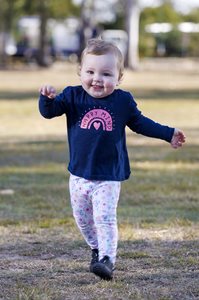Learning to walk is a special moment for any toddler, but it was a giant step for Ayla Johanson.
The 16-month-old was born with hip dysplasia – a condition that required her to undergo an operation and spend 18 weeks wearing casts and braces to ensure her hip developed normally.
Today nothing can slow Ayla down after her successful treatment by Mater orthopaedic specialist Dr Sarah Metz, but many other children will not be as lucky.
Hip dysplasia occurs when the hip socket does not fully cover the ball of the thighbone, causing the joint to wear out and often triggering early arthritis and lifelong disability.
Mum Kate Johanson, of Tingalpa, Brisbane, is urging other parents to be aware of the condition, which affects one in 600 girls and one in 3000 boys.
"At Ayla's first check two days after birth they noticed a click in her hip and referred us back for a follow-up check," Kate said.
"She had two more ultrasounds that were borderline, but there seemed to be nothing wrong with her development at all.
"When she had an X-ray at six months we expected to get the all-clear, but instead we were told her hip had partially dislocated since the last scan.
"It was horrifying – we thought Ayla was a healthy baby and then we were told she needed to go into hospital the next week."
During a 'closed reduction' procedure at Mater Children's Private Brisbane, Ayla's hip ligaments were released and the hip reduced into the acetabulum (hip bone socket). She was then fitted with spica plaster cast from her waist to her ankles.
After six weeks she went under general anaesthetic again for a second plaster cast to be moulded to her growing limbs, and she was subsequently fitted with a rhino cast that encased her pelvis.
The treatment was intended to allow Ayla's hip joint to develop normally and – although she is still being monitored – it seems to have worked.
"Ayla started rolling while she was in her cast, started crawling while she was in her brace and now she's up running around – there's no stopping her!" Kate said.
"It's a relief to know this problem was detected and dealt with while Ayla was so young.
"If it hadn't, she would have faced development issues, delayed walking and it may not have been picked up until she started playing sport."
Dr Metz, who is involved with the Global Hip Dysplasia Registry (GHDR), an international registry for hip dysplasia started at Vancouver's British Columbia Children's Hospital (BCCH), said the cause of hip dysplasia is unknown, but that risk factors included breech births, first born, high birth weight and a family history of the condition.
"It's especially common among girls and it's important for hip dysplasia to be diagnosed and treated as early as possible," Dr Metz said.
"All babies are routinely checked after birth – but moderate cases can still be hard to detect clinically. If there are any risk factors or findings on the examination, an ultrasound should be done to see if hip dysplasia is present.
"Parents of newborns need to be aware of this problem. They might feel 'clicks' or 'clunks' in their baby' hips or notice that their legs are not symmetrical when stretched out, particularly when changing nappies.
"Seek medical advice if you think there might be a problem.
"Ayla was fortunate to begin her treatment at six months – older children have to undergo a more significant operation.
"Sometimes this condition is not diagnosed until someone has already developed arthritis. Some people then go on to need to have a hip replacement in their 20s or 30s.
"Hip dysplasia is common, but it is curable – so parents need to know the signs."


Images: Pictures show Ayla Johanson today and during her hip dysplasia, and with parents Kate and Ben Johanson and sister Belle.






